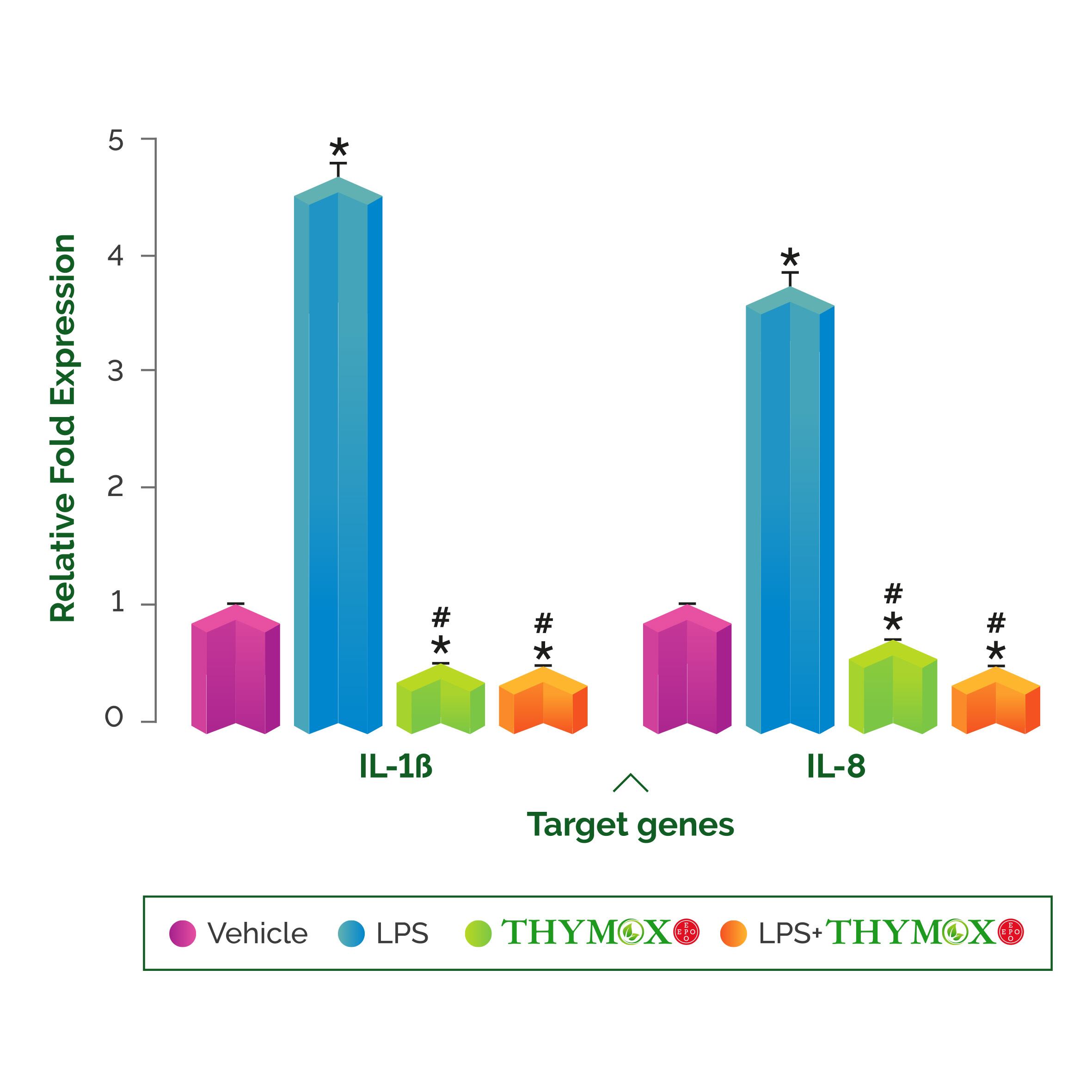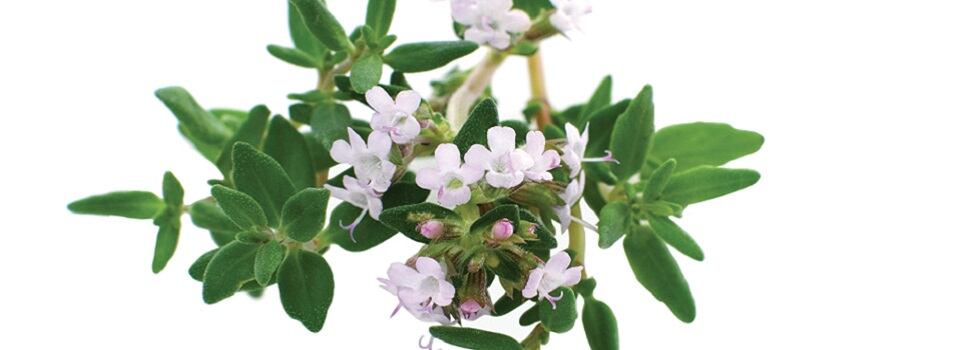Also known as common thyme or garden thyme, thyme is an evergreen dwarf shrub, indigenous to the Mediterranean area, Northern Africa and some parts of Asia, nowadays extensively cultivated all over the world. Its habitats consist in dry slopes, rocks and maquis, where it can be found on sandy or loamy soils.
Thyme belongs to the Lamiaceae botanical family. The plant can grow up to 50 cm high and has bushy aspect, with erect, woody stems. The tiny, gray-green leaves are short petioled, linear or elliptic; they have a characteristic aromatic odor, resembling that of thymol. It has lilac, pink, tubular, labiate flowers arranged in axillary clusters; they flourish during summer (from June to August). The fruit is made of four brown ovoid nutlets.
Parts used are dried leaves, collected at blooming time. The main components of thyme leaf are a volatile oil (min. 1,2%) containing as chief components thymol, p-cymene and carvacrol; caffeic acid derivatives (rosmarinic acid); flavonoids (luteolin, apigenin etc.), triterpenes (ursolic acid, oleanolic acid).
Thyme has a very long history of folk use in the Mediterranean area. It was mentioned by Greek and Roman classical writers such as Dioscorides, Hippocrates, Pliny and Virgil. The antibacterial action of thyme essential oil was demonstrated by Chamberland in 1887 on a carbuncle infection. Its efficacy was later experimented in France on other infectious agents, such as those causing typhus and distemper.
Thyme is used in treating respiratory diseases and a variety of other ailments. It is also spasmolytic, vermifuge and expectorant; it is used internally for catarrh of the upper respiratory tract, dyspeptic complaints, asthma, laryngitis, chronic gastritis and whooping cough. The German Commission E has approved the use of thyme for cough, bronchitis and whooping cough. Externally it is used as a mouthwash and gargle for inflammations of the mouth and throat, tonsillitis, pruritus, dermatoses and poorly healing wounds.
The expectorant action has been attributed to the essential oil fraction (thymol and carvacrol), which increases the mucociliary activity; an expectorant effect on ciliary activity was demonstrated in animal studies for the terpenes too. Moreover, the flavone fraction (luteolin) was shown to have antispasmodic activity in a preconsctricted rat smooth muscle trachea model. Therefore, it seems that both the antispasmodic effect and the respiratory clearance are due to a synergic action of different components (aqueous and oil fractions) of the thyme extract.
The respiratory tract has epithelial cells characterized by cilia on the surface and the expectoration could consist in the movement of mucus through the respiratory tract, from lungs to upper airways, thanks to an efficient beating of the cilia, by a Ca2+-mediated mechanism.
Thymox-EPO
Thymox-EPO is a dry powdered extract obtained from Thymus vulgaris L aerial parts by hydroalcoholic (ethanol 70% - water 30%) extraction (general method according to Eur. Ph. 8.0). It is standardized to contain 0,3 % total phenols, calculated as thymol (spectrophotometric method, DAB 10).
The botanical species is certified by DNA barcoding analysis. No harmful solvent is used in the manufacturing process, which is entirely made in Italy, with full traceability from the field to the final packaging and a production chain that is checked at every stage. The quantification of bioactive compounds is accurately performed by sophisticated analytical methods and in compliance with EU legislation on food and food supplements.
Its efficacy is based on preclinical evidence, providing its double effect as an anti-inflammatory and expectorant agent, which makes Thymox-EPO suitable for respiratory tract inflammations, asthma, dry and productive cough.
Activity
Thymox-EPO has been tested on 3D in vitro cellular model, which faithfully reproduces the physiological condition. It was demonstrated that Thymox-EPO has a good expectorant and anti-inflammatory activity.
Thymox is able to reduce inflammation induced by LPS (Lypopolysaccharide) treatment on human respiratory epithelial cells (11), by decreasing pro-inflammatory mediator proteins as NF-kB p65 and NF-kB p52 and pro-inflammatory cytokines IL-1β and IL-8, at both mRNA and protein levels, evidencing so a strong anti-inflammatory property. (figure 1)

The respiratory tract has epithelial cells that are characterized by cilia on the surface. Expectoration consists in the movement of mucus through the respiratory tract thanks to the efficient beating of the cilia a Ca2+-mediated mechanism.

Thymox was shown to increase extracellular cAMP levels; it increases Ca 2+ influx while decreasing extracellular Ca2+ level; therefore, enhancing ciliary beating frequency. By increasing the frequency of beating, Thymox- EPO helps mucus clearance (expectoration). (figure 2)
The recommended daily dosage is 10 g drug with 0.03% phenol, calculated as thymol, corresponding to 1 g of Thymox-EPO (Thyme dry extract 0.3%).

References
Gruenwald J. et al. PDR for herbal medicines, 4th Ed. Thomson, 2007
Plants for a future (PFAF) database, www.pfaf.org
Chevallier A., “The Encyclopedia of Medicinal Plants”, Dorling Kindersley, London 1996
European Pharmacopoeia 8.2, Thymi herba (07/2014:0865)
Valnet J., “Aromathérapie - Traitement des maladies par les essences ded plantes”, Librairie Maloine S.A. Editeur, Paris 1974
German Commission E Monographs, Vol. 2 Bundesanzeiger nr. 226 (1992)
Capasso F., Grandolini G., Izzo A.A., “Fitoterapia”, Springer-Verlag Italia, 2006
Begrow F., Engelbertz J. et al. Impact of thymol in thyme extracts on their antispasmodic action and ciliary activity. Plantamed. 2010 Mar;76(4):311-8
Engelbertz J., Lechtenberg M., Bioassay-guided fractionation of a thymol-deprived hydrophilic thyme extract and its antispasmodic effect. J Ethnopharmacol. 2012 June; 141(3):848-53
Nabissi M, Oliviero M, Morelli MB, Innarelli R, Amantini C, Santoni G, Maggi F. Regulation of mucociliary beating frequency, by thyme extract in primary cell lines derived from patients affected by chronic obstructive pulmonary disease. Biomedicine & Pharmacotherapy 2018; 105 (2018) 1248–1253
Oliviero M, Romilde I, Morelli MB, Valisi M, Nicotra G, Amantini C, Cardinali C, Santoni G,Maggi F, Nabissi M. Evaluations of thyme extract effects in human normal bronchial and tracheal epithelial cell lines and in human lung cancer cell line. Chem Biol Interact. 2016 Aug 25; 256:125-33





